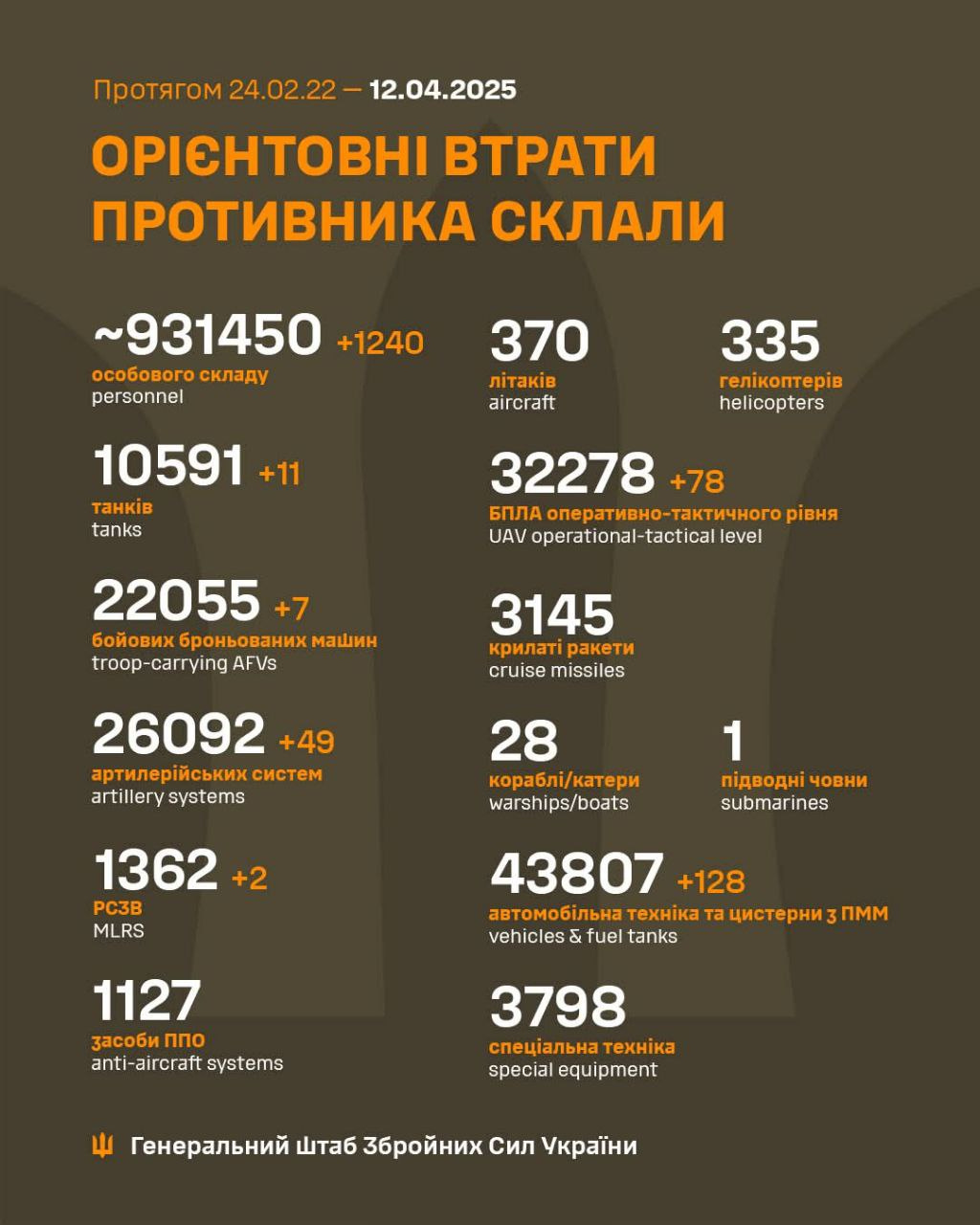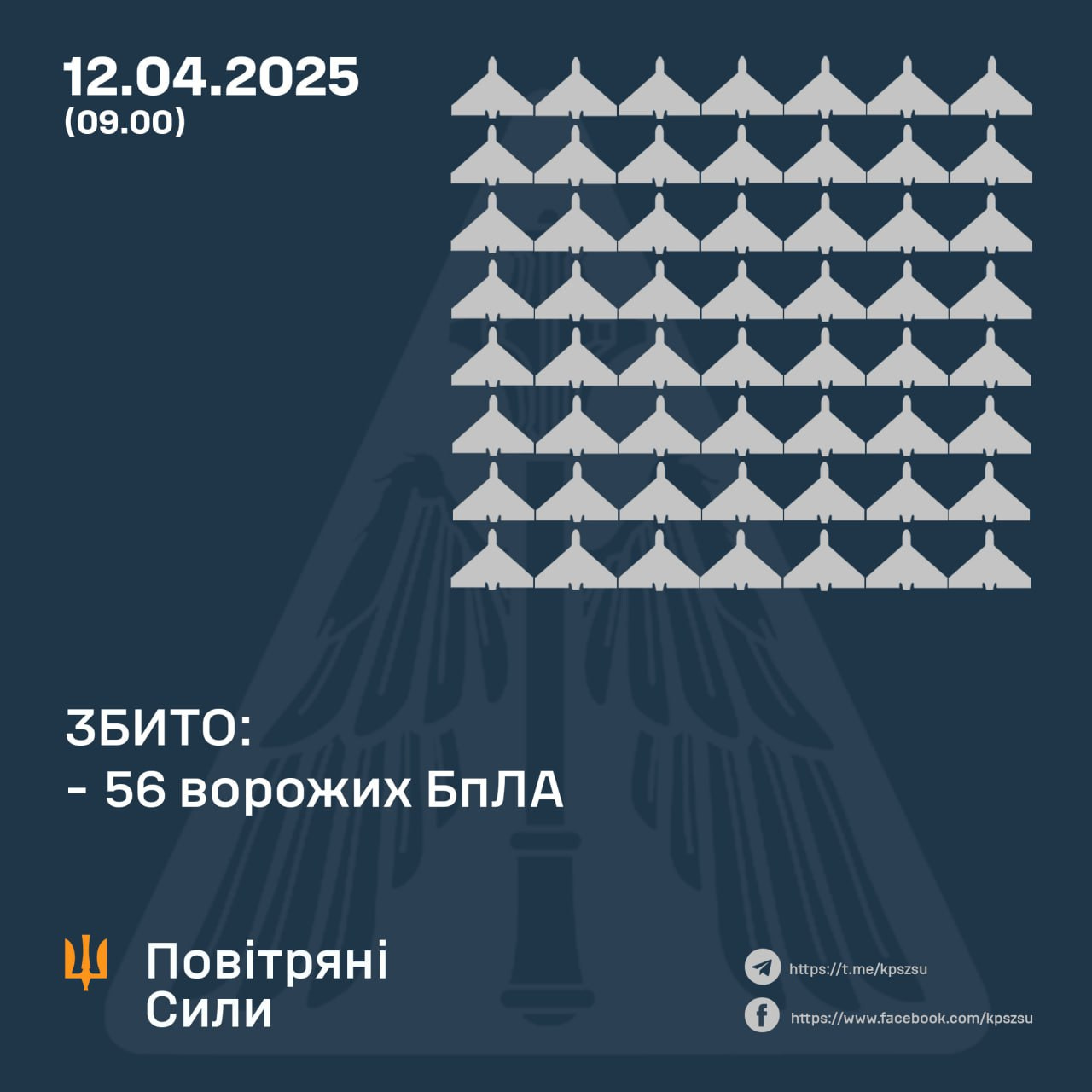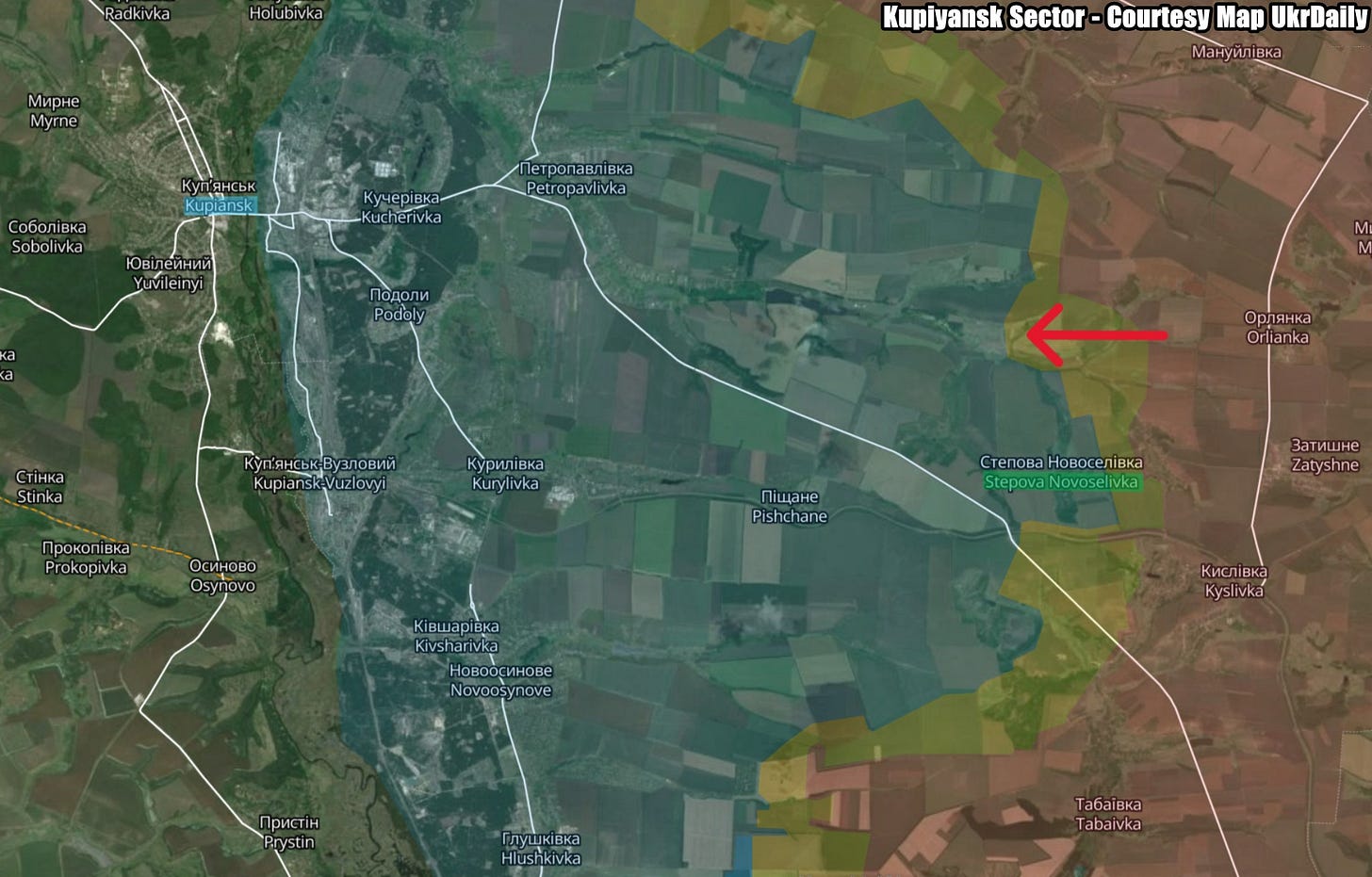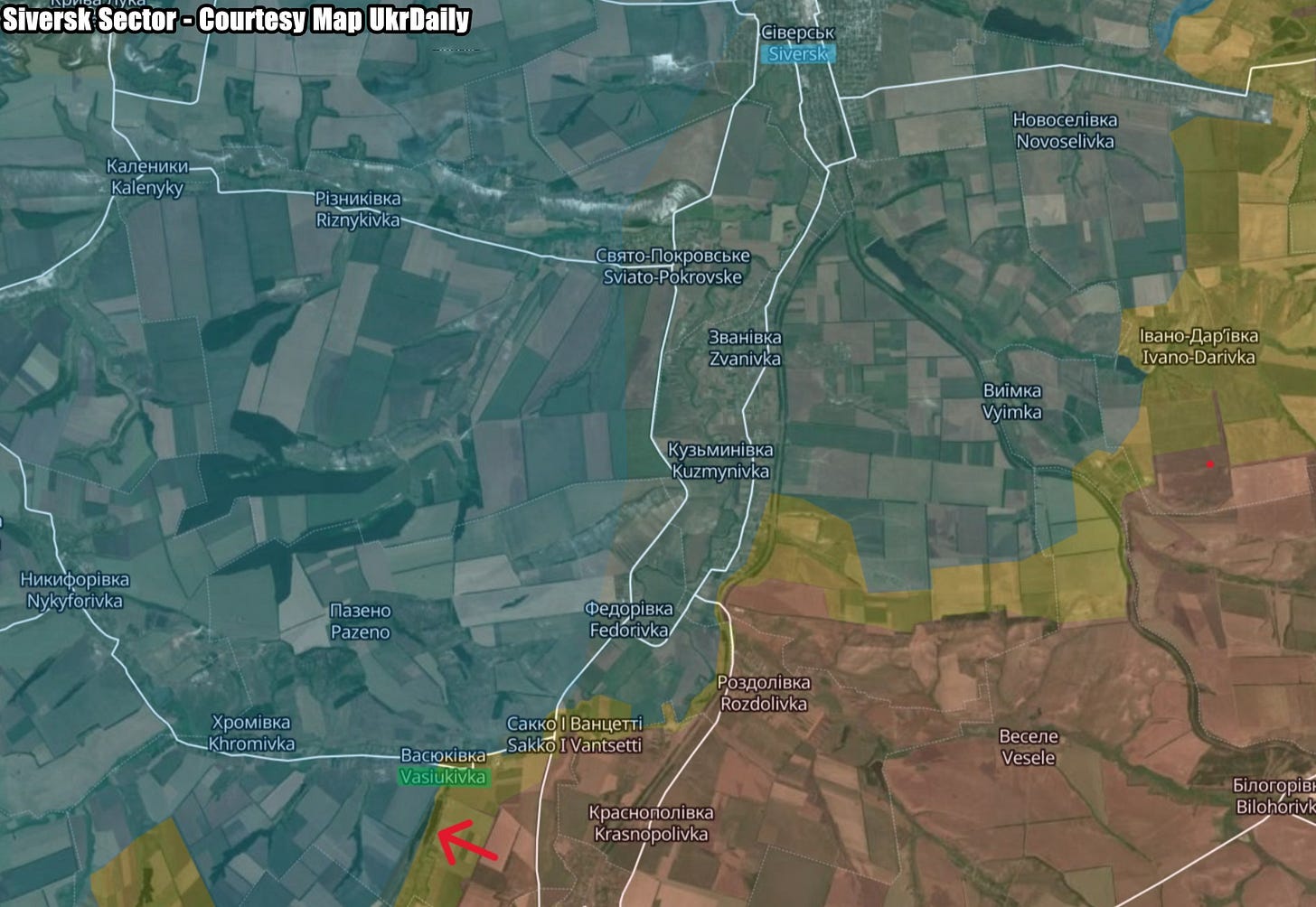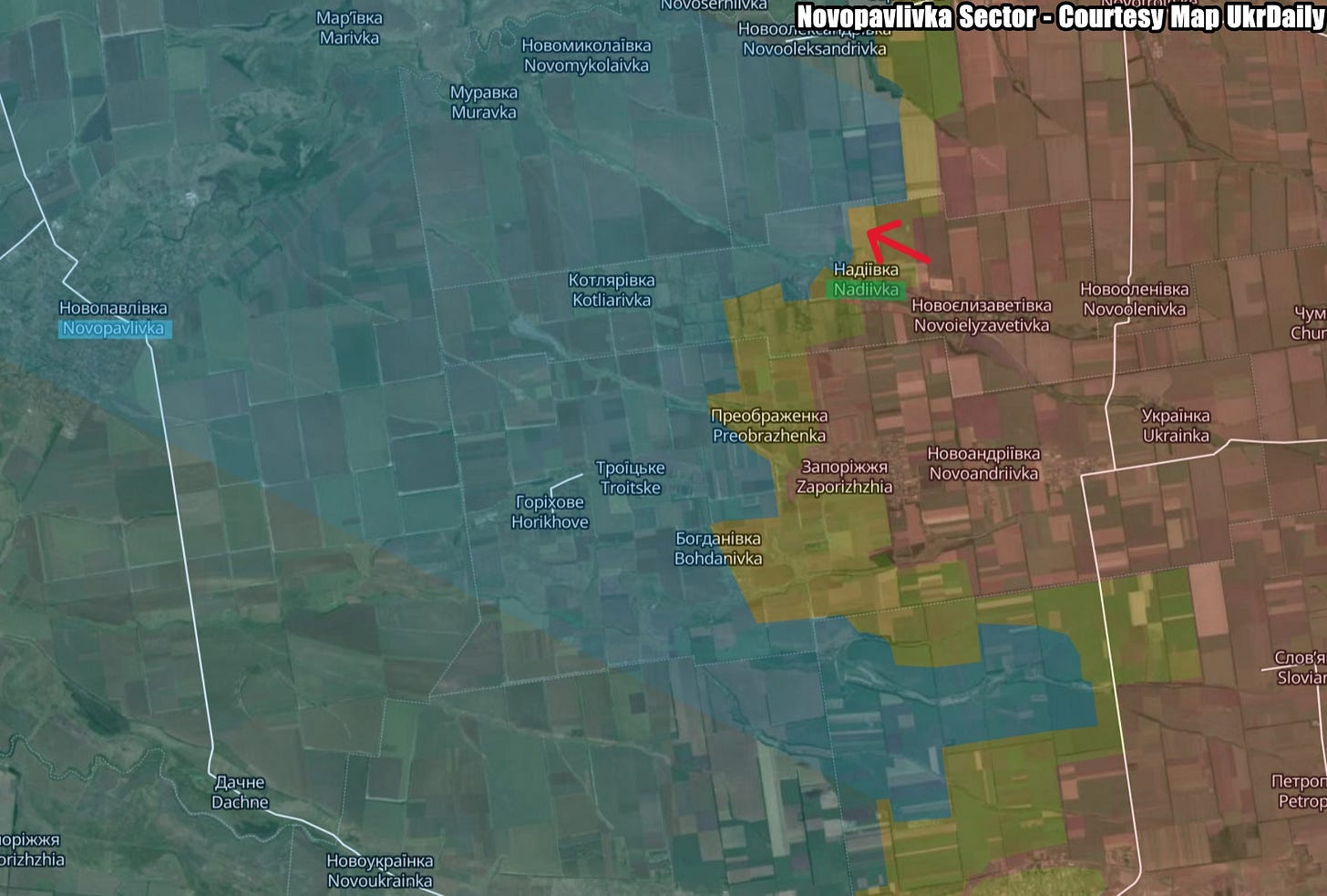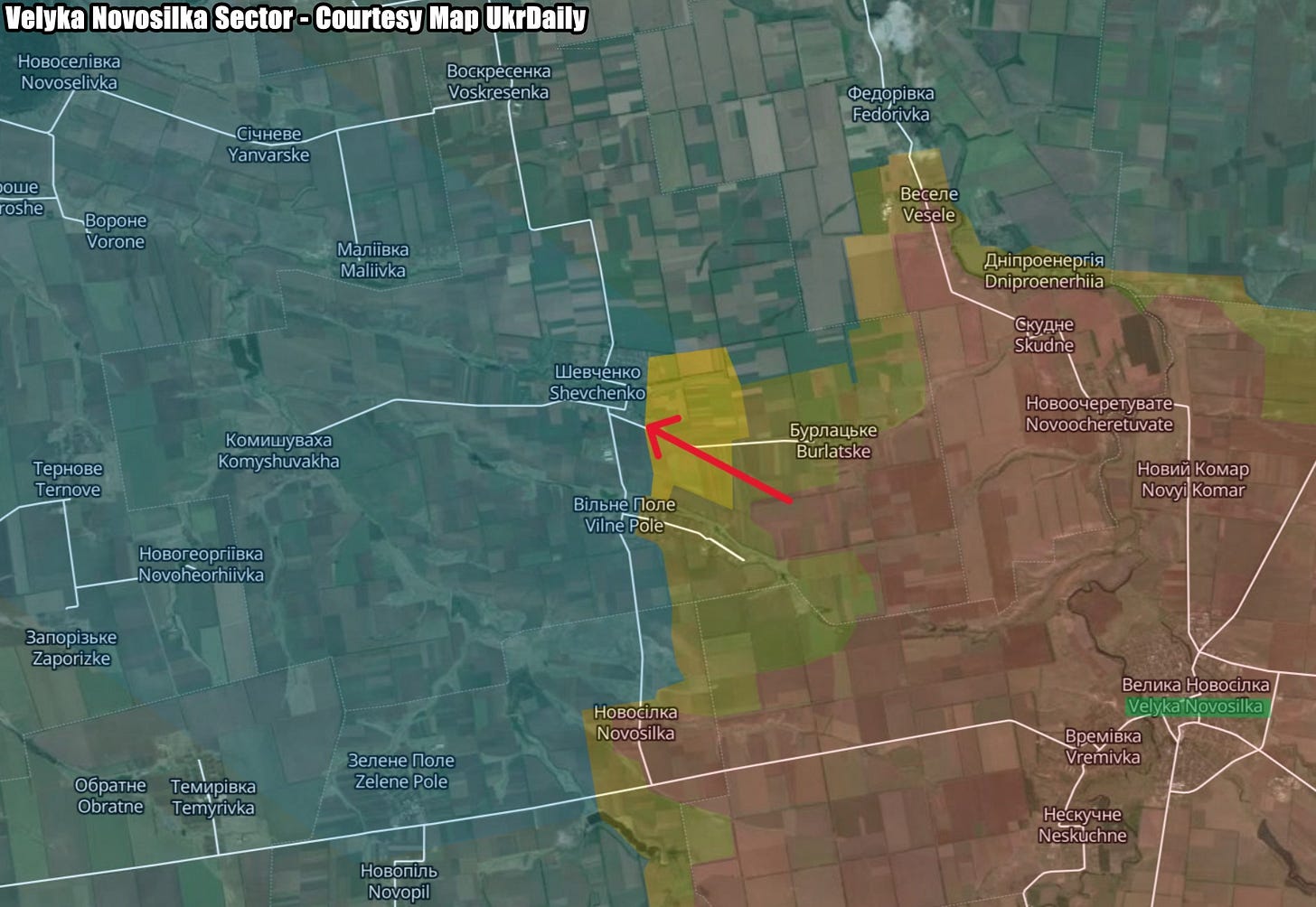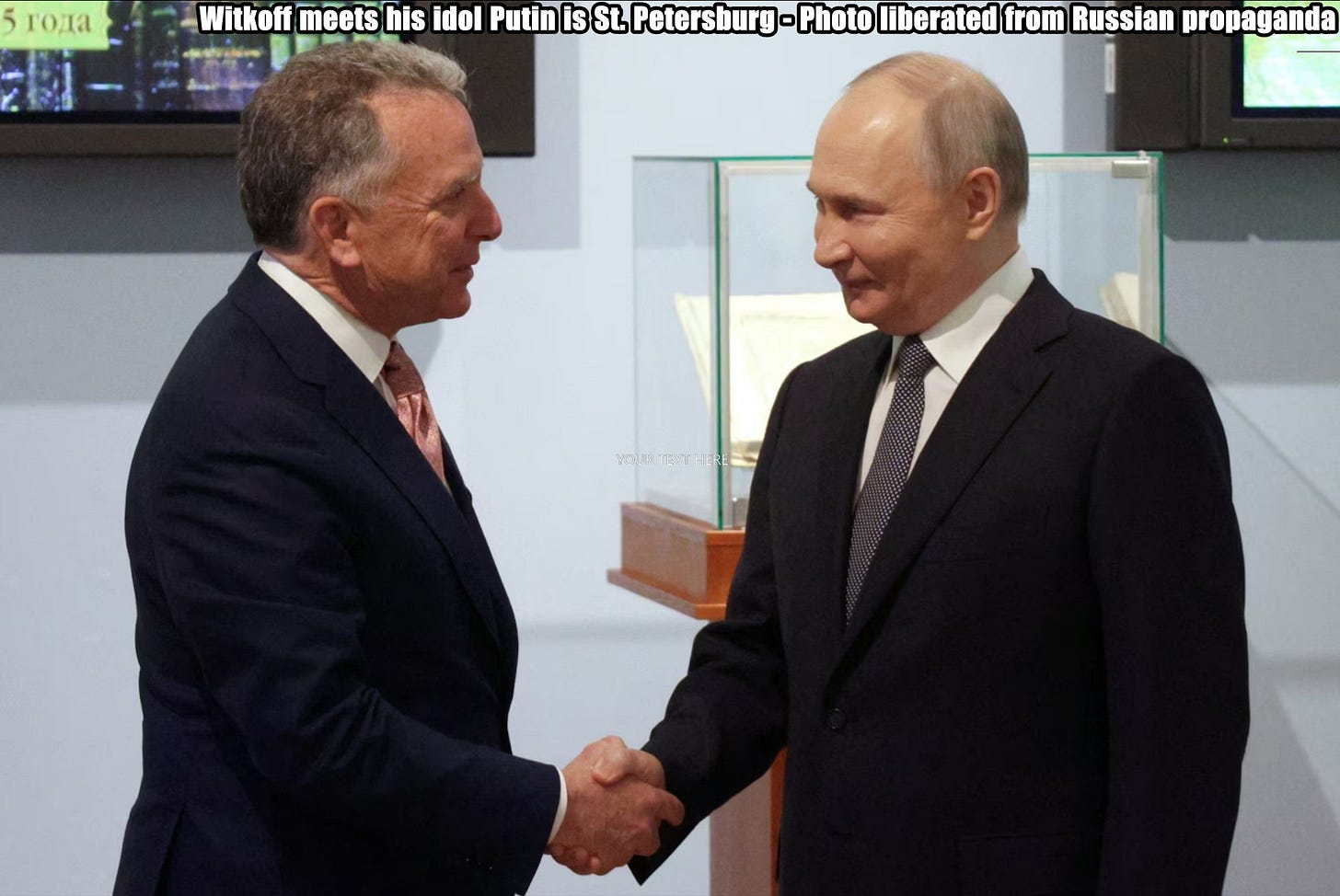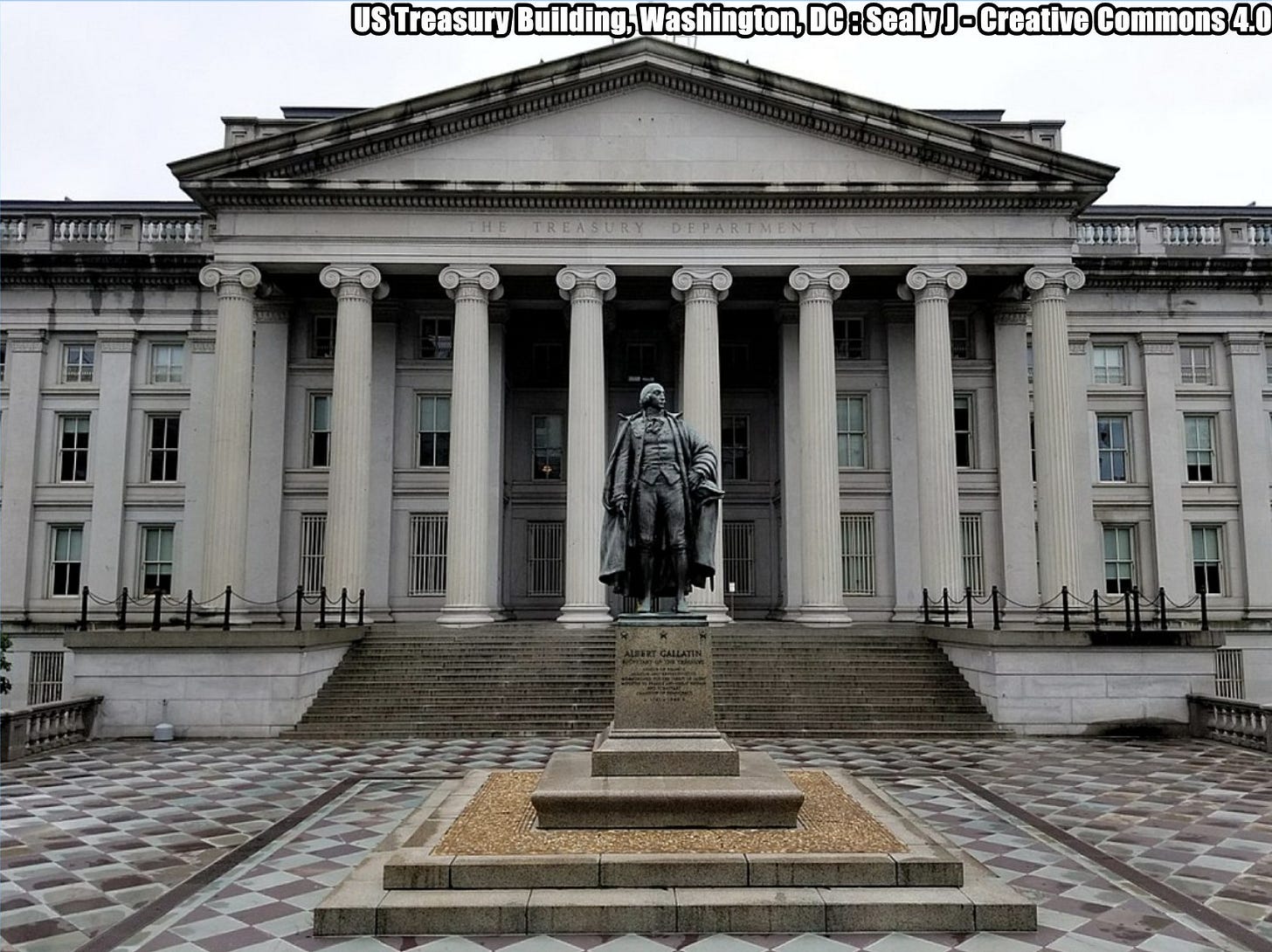Slava Ukraini! In early 2022 I began a Telegram channel aggregating news from a number of sources daily on the war in Ukraine. In June 2023 I began providing a daily draft for the Ukraine War Brief Podcast collecting news from over 70 sources daily, which formed the basis of the script. While the Podcast no longer exists I have continued to make this Brief available for my followers here on Substack for those who wish to keep up with the news from the war.
All the latest news on the Russo-Ukraine War 6 days per week
ALONG THE CONTACT LINE
GSAFU Morning Report
For: Apr 11, 2025
The General Staff of the Armed Forces of Ukraine in its Operational Information update at 08:00 on Apr 11 stated that day 1144 of the full-scale invasion of the Russian Federation against Ukraine had begun.
The situation on the line of combat remains tense in some sectors. Ukrainian defenders continue to actively counteract the Russian aggressor, causing them significant losses in personnel, equipment and technology. Exhausting the enemy along the entire front line and continuing to disrupt the plans of Russian occupiers to advance deeper into the territory of Ukraine.
During the past day,149 combat engagements took place.
Over the past 24 hours, the enemy carried out 101 air strikes, used 2,789 drones and fired approximately 6,400 artillery shells across the positions of Ukrainian forces and civilians.
Air Force Daily Report
56 ENEMY UAVS SHOT DOWN, 24 SIMULATOR UAVS FAILED TO REACH THEIR TARGETS (LOCATIONALLY LOST)
➖➖➖➖➖➖➖➖➖
On the night of April 12 (from 8:00 p.m. on April 11), the enemy attacked with 88 Shahed attack UAVs and simulator drones of various types from the directions: Kursk, Millerovo, Primorsko-Akhtarsk - Russia.
The air attack was repelled by aviation, anti-aircraft missile troops, electronic warfare units, and mobile fire groups of the Defense Forces of Ukraine.
As of 09:00, it has been confirmed that 56 Shahed attack UAVs (and other types of drones) have been shot down in the north, south, east, and center of the country.
24 enemy drone simulators — lost in location (without negative consequences).
The Kharkiv, Kyiv, Odesa, Dnipropetrovsk, and Donetsk regions were affected by the Russian attack.
Combat Operations in the Russian Federation
The Institute for the Study of War (ISW), a US based think tank, in its -- Russian Offensive Campaign Assessment reported that:
Kursk Salient: There have been no major changes to the combat environment since our last report.
Belgorod Incursion: Ukrainian forces continued limited ground attacks in Belgorod Oblast on Apr 11.
A Russian milblogger claimed that Ukrainian forces attacked northwest of Belgorod City near Popovka and Demidovka.
The Khortytsia operational-strategic group
(Responsible for the northeastern part of Ukraine. )
Kupyansk Sector: Russian forces recently advanced in the Kupyansk direction.
Geolocated footage posted on Apr 11 shows Russian forces conducting an attack with the support of four armored vehicles, indicating that Russian forces recently advanced north of Stepova Novoselivka (southeast of Kupyansk).
Siversk Sector: Russian forces recently advanced in the Siversk direction.
Geolocated footage published on Apr 11 indicates that Russian forces recently advanced south of Vasyukivka (southwest of Siversk).
Toretsk Sector: Russian forces advanced further northwest of Toretsk during a recent assault with armored vehicle support, but it is unclear if Russian forces maintain enduring positions in the area.
Geolocated footage published on Apr 11 indicates that Russian forces recently advanced northeast of Nelipivka (northwest of Toretsk) during a recent assault along the T-0516 Toretsk-Kostyantynivka highway. It is unclear if Russian forces maintain enduring positions along the highway, given that the footage shows Ukrainian forces striking the Russian vehicles involved in the assault.
ISW assesses that Russian forces advanced near Nelipivka as part of a Russian push that reached anomalously far ahead of the main Russian line, not that Russian forces maintain a sustained presence in the area. ISW defines a Russian advance as territory where Russian forces have operated in or launched attacks from, but over which Russian forces do not exercise control. ISW will refine the Russian salient northwest of Toretsk as additional information becomes available.
The Tavria operational-strategic group
(Responsible for the central-eastern and southeastern part of Ukraine.)
Novopavlivka Sector : Russian forces recently advanced in the Novopavlivka direction.
Geolocated footage published on Apr 11 indicates that Russian forces recently advanced northeast of Nadiivka (east of Novopavlivka).
Velyka Novosilka Sector: Russian forces recently advanced near Velyka Novosilka.
Geolocated footage published on Apr 10 indicates that Russian forces recently advanced east of Shevchenko (northwest of Velyka Novosilka).
Zaporizhia Sector: Russian forces continued offensive operations in western Zaporizhia Oblast on April 11 but did not advance.
Russian forces execute more Ukrainian POWs.
Russian forces recently executed Ukrainian prisoners of war (POWs) in western Zaporizhia Oblast amid continued reports of systematic executions of Ukrainian POWs across the theater of war. The Associated Press (AP) reported on Apr 10 that it obtained a video from Ukrainian and Russian drones showing Russian soldiers executing Ukrainian POWs surrendering in Pyatykhatky (northwest of Robotyne). Ukrainian officials reacted to the footage confirming the executions and reiterated that Russian executions of Ukrainian POWs are "systematic."
ISW observed a sharp increase in credible reports and footage of Russian forces executing Ukrainian POWs throughout 2024 and 2025 and continues to assess that Russian military commanders are either complicit in or directly enabling subordinates to execute Ukrainian POWs in violation of international law.
The Odesa operational-strategic group
(Responsible for Kherson, Qırım, (also known as Crimea) and the Black Sea.)
There have been no major changes to the combat environment since our last report.
TEMPORARILY OCCUPIED TERRITORIES
Nothing major to report.
THE HOME FRONT
Ukrainian Domestic missile production increases eightfold in 2024.
Ukraine has significantly ramped up weapons manufacturing over the past year and is using domestically produced ballistic and cruise missiles every month, the Kyiv Independet reported citing the country’s Minister for Strategic Industries.
At a briefing marking Ukraine’s Gunsmith Day, Strategic Industries Minister Herman Smetanin said the country increased cruise missile production eightfold in 2024 compared to the previous year. He highlighted the progress since 2022, when Ukraine was only able to manufacture a single type of cruise missile, the Neptune.
“Last year, we introduced many new models, allowing us to grow production eightfold compared to 2023,” Smetanin said.
Ukraine has also more than doubled its production of long-range drones in 2024 compared to the previous year, which is a 22-fold increase compared to 2022. In total, 324 new types of weapons were developed in Ukraine by the end of 2024.
Smetanin said Ukraine produced $9 billion worth of arms in 2024, and the defense industry is on track to nearly quadruple that amount by the end of 2025. “We already foresee growth this year,” he said. “By the end of 2025, we will have the capacity to produce $35 billion worth of military equipment domestically.”
President’s Advisor Oleksandr Kamyshin added that Ukraine can now supply its armed forces with nearly the full range of necessary military goods.
“Today, according to various estimates, 30% to 40% of what our troops use on the front lines is made in Ukraine,” Kamyshin said. “It’s not only about war — it’s about our economy. As of last year, defense manufacturing made up a significant share of our GDP. After our victory, I’m confident we’ll be exporting Ukrainian-made weapons to the world.”
Ukraine has been rapidly developing its domestic arms industry since Russia’s full-scale invasion in February 2022. In December 2024, President Volodymyr Zelensky said the country aims to produce 30,000 long-range drones and 3,000 missiles. As of November 2024, Ukraine had produced its first 100 domestically made missiles.
Ukraine has also turned to local production to address battlefield shortages and reduce dependency on foreign supplies, including new domestic artillery contracts.
Fires, injuries reported after Russian drone attack on Kyiv.
Russian forces launched drone attacks on Kyiv overnight on April 12, causing multiple fires and injuring at least two people, the Kyiv Indeprendent reported citing Mayor Vitali Klitschko said.
In the Darnytskyi district of the city, a fire erupted at a home after drone debris fell on the property. While in the Svyatoshyn district, two people were injured as a result of the attack.
A total of three warehouses across the city caught fire as a result of the attack, Ukraine's State Emergency Service said.
Emergency crews are currently on-scene, Klitschko said. No information was immediately available on the status of the injured victims.
Russia has regularly targeted civilian infrastructure since the onset of its full-scale war against Ukraine in February 2022, particularly in the country's capital, Kyiv.
Russia's latest large-scale attack on the capital occurred overnight on April 6 and killed one person and wounded three others.
The U.S. has been in talks with Ukraine and Russia to negotiate an end to Russia's war against Ukraine.
Ukraine has already agreed to a U.S.-proposed full 30-day ceasefire, saying on March 11 that Kyiv is ready if Russia also agrees to the terms. So far, Moscow has refused.
RUSSIAN WORLD
Graves of Russian soldiers are being systematically desecrated.
In a pattern of desecration In Russia, graves of soldiers killed in Ukraine are being set on fire, defaced with swastikas, and smeared with blood and feces Meduza reports.
Since the start of Russia’s full-scale invasion of Ukraine, the graves of soldiers who died fighting for Russia have been regularly vandalized — set on fire, defaced with swastikas, and stripped of military flags. Over the past three years, journalists from Sever.Realii, a division of Radio Free Europe/Radio Liberty, have documented at least 55 such cases. In a new report, they examine what’s happening at the gravesites of those killed in Ukraine. Meduza shares a translation of their investigation.
Acts of vandalism targeting military graves in Russia and Russian-occupied Ukraine began in the early months of the full-scale war. The first known incident took place in annexed Crimea, where Valeria Goldenberg, a 61-year-old pensioner originally from Poltava, dumped blood and feces on the grave of Valentin Isaychev, a mortar operator killed in the war. Goldenberg said she acted “out of a sense of revenge and compassion for the people of Ukraine.” She pleaded guilty and was sentenced to two years in prison. She has since been released.
In 2022, such cases remained rare. That year, aside from Goldenberg’s, only two other criminal cases were reported.
By 2023, the number of reported cases had surged sevenfold. Sever.Realii documented at least 21 incidents, including arson attacks on graves and defacements featuring the letter Z — now a symbol of Russia’s invasion of Ukraine — as well as Nazi imagery.
In 2024, the number of vandalism cases targeting the graves of Russian soldiers who fought in Ukraine continued to rise, though the increase was modest — 25 incidents were reported that year. Teenagers were frequently involved.
By early 2025, at least five more cases of grave desecration had been reported.
Russia’s criminal code includes two articles that address the desecration of graves. Article 243.4 covers the destruction or damage of military burial sites, while Article 244 criminalizes the abuse of human remains and the desecration of burial places more broadly.
RELATED INTERNATIONAL NEWS
Trump envoy's embrace of Russian demands worries Republicans, U.S. allies.
Less than 48 hours after dining with a negotiator sent by Russian President Vladimir Putin in Washington last week, Steve Witkoff, the U.S. special envoy leading talks with Moscow, sat down with President Donald Trump in the White House and delivered a clear message, Reuters reports.
The fastest way to broker a ceasefire in Ukraine, said Witkoff, was to support a strategy that would give Russia ownership of four eastern Ukrainian regions it attempted to annex illegally in 2022, two U.S. officials and five people familiar with the situation told Reuters.
It was a point Witkoff had made previously – and publicly in a podcast interview with conservative media personality Tucker Carlson last month – but one that Kyiv has repeatedly rejected and that some U.S. and European officials have dismissed as a maximalist Russian demand.
In the meeting with Trump, General Keith Kellogg, the president’s Ukraine envoy, pushed back against Witkoff, saying Ukraine, though willing to negotiate some terms related to disputed land, would never agree to unilaterally cede total ownership of the territories to Russia, said two of the sources.
The meeting ended without Trump making a decision to change the U.S. strategy. Witkoff traveled to Russia Friday to meet Putin.
Trump administration officials are increasingly at odds over how to break the deadlock between Ukraine and Russia, with Witkoff and Kellogg - who favors more direct support for Ukraine - disagreeing on the best course forward, according to the U.S. officials and people familiar with the matter and four Western diplomats who are in touch with administration officials.
In a break with normal security procedures, Witkoff had invited Kirill Dmitriev, the Russian envoy who is under U.S. sanctions following Russia's invasion, to his personal residence for dinner before the White House meeting.
That set off alarms inside the White House and the State Department, according to two people familiar with the situation. U.S. officials avoid hosting officials from Russia – which has sophisticated intelligence capabilities – to their homes. The dinner was rescheduled and took place at the White House instead.
Witkoff, an old friend of Trump's who has helped secure key diplomatic victories for the president, has garnered some support from the Republican Party's Ukraine skeptics but his proposals have stoked outrage among other Republicans who believe the administration has turned too sharply toward Moscow.
Some Republicans on Capitol Hill were so concerned about Witkoff's apparent pro-Russia stance in the Carlson interview that several called National Security Adviser Mike Waltz and Secretary of State Marco Rubio afterward to complain, according to a person familiar with the calls.
Since taking office in January, Trump has upended U.S. foreign policy, pressing Ukraine to agree to a ceasefire while easing many of the measures the Biden administration had taken to punish Russia for its 2022 full-scale invasion of its neighbor.
Some U.S. and European officials worry that as Witkoff pursues Trump's strategy, the Russians are taking advantage of his lack of experience at the negotiating table, according to the two U.S. officials and more than a dozen other people familiar with the administration’s internal deliberations, including Western diplomats.
"Witkoff must go, and Rubio must take his place," read a March 26 letter from Eric Levine, a major Republican donor. The letter, sent to a group including Republican donors and seen by Reuters, was written after the Carlson interview and a Fox News appearance, and criticized Witkoff for praising Putin.
Trump has repeatedly said that he wants to broker a ceasefire in Ukraine by May, arguing the U.S. must end a conflict that has killed hundreds of thousands and risks a direct confrontation between the U.S. and nuclear-armed Russia.
But two partial ceasefire deals – one on energy infrastructure and one in the Black Sea – have stalled and the president has become frustrated over the lack of progress.
Witkoff plays a central - and expanding - role in the Trump administration's foreign policy. Even before Trump took office, Witkoff had helped secure a long-sought Gaza ceasefire - which has since unraveled - and later negotiated the return of a U.S. citizen, Marc Fogel, from Russia.
He traveled to Russia on Friday to meet Putin and is expected in the Middle East for talks with Iran on Saturday, effectively leading yet another top priority national security assignment.
Witkoff first publicly floated the idea of handing over to Russia the four Ukrainian regions - Luhansk, Donetsk, Zaporizhzhia and Kherson - in the March 21 interview with Carlson.
“They’re Russian-speaking,” he said of the eastern territories. “There have been referendums where the overwhelming majority of the people have indicated that they want to be under Russian rule.”
Witkoff’s comments shocked many U.S. national security officials - the special envoy’s rhetoric mirrored that of Russian officials. Western governments have called the hastily organized referendum votes a sham and pledged not to recognize their results.
Just a few days after the Carlson interview, the Wall Street Journal, owned by Rupert Murdoch's News Corp, published an op-ed titled “Steve Witkoff Takes the Kremlin’s Side.”
Democrats have weighed in, too.
“Witkoff and Trump have committed a cardinal sin of diplomacy: they have put their desperation for a deal on full display,” said Ned Price, a former spokesperson for the State Department under President Joe Biden.
“Special Envoy Witkoff has brought a wealth of private sector negotiating experience and urgency to the diplomatic stage and we’re already seeing results in just a few weeks,” National Security Adviser Mike Waltz told the Hill in a statement.
Despite frequent conversations between Witkoff and Kellogg, the administration has not established a coordinated Ukraine policy process. Contrary to standard practice, the National Security Council has hosted only one principals' meeting - a meeting that includes all or most of the president's top national security advisers - on the issue, a person familiar with the matter said, leading to greater confusion inside the administration and among allies in Europe about the direction of the peace talks.
Two senior Western diplomats who are in touch with the administration said they believe Washington lacks a “clear plan” on how to move forward and what to do if Russia continues to delay.
“We sometimes hear contradictory things from different parts of the administration," one of the diplomats, speaking on the condition of anonymity, said. "That also adds to the sense that there is no real plan here.”
US, Ukraine hold tense talks as mineral deal remains elusive.
U.S. and Ukrainian officials met on Friday on a U.S. proposal to gain access to Ukraine's mineral wealth, a source with knowledge of the matter said, adding that prospects for a breakthrough were scant given the meeting's "antagonistic" atmosphere, Reuters reports.
The strains in the Washington talks stemmed from the Trump administration's latest draft proposal, which is more expansive than the original version, the source said.
"The negotiating environment is very antagonistic," the source said, pointing to the "maximalist" draft submitted by the Trump administration last month.
A Treasury Department spokesperson confirmed the discussions, calling them "technical in nature."
The latest draft would give the U.S. privileged access to Ukraine's mineral deposits and require Kyiv to place in a joint investment fund all income from the exploitation of natural resources by Ukrainian state and private firms.
The proposed deal, however, would not provide U.S. security guarantees to Kyiv - a top priority of Ukrainian President Volodymyr Zelenskyy - for its fight against Russian forces occupying some 20% of its territory.
The source said that one of the "Easter eggs" found in the document was a U.S. demand that the U.S. government's International Development Finance Corporation take control of a natural gas pipeline from Russian energy giant Gazprom across Ukraine to Europe.
The Ukrainian government has hired law firm Hogan Lovells as an outside adviser on the minerals deal, the source said.
Zelenskyy on Wednesday said a minerals deal should be profitable for both countries and could be structured in a way that would help modernize Ukraine.
Top Ukrainian officials including Prime Minister Denys Shmyhal and Finance Minister Serhiy Marchenko will be in Washington in two weeks for International Monetary Fund and World Bank meetings, including a Ukraine-focused ministers' meeting on April 25, multiple sources familiar with the plans said.
U.S. President Donald Trump is seeking a deal covering Ukraine's minerals, which include prized rare earths, as part of his effort to end the war and as a way to recover billions of dollars in U.S. military assistance to Kyiv.
MILITARY & TECH
Norway pledges around $940 million to train and equip Ukrainian brigade.
Norway will allocate 10 billion Norwegian kroner (approximately $937 million) in 2025 to help equip and train a Ukrainian military brigade, Defense Minister Tore O. Sandvik announced on April 11 during a Ukraine Defense Contact Group meeting, the Kyiv Independent reports citing the Norwegian government.
The initiative is part of a broader Nordic-Baltic effort to support Ukraine’s land forces. Norway will take the lead role in the training component, working in close coordination with Ukrainian authorities and allied nations.
“Norway stands united with Europe for stronger support for Ukraine, politically, economically, and militarily,” Sandvik said. “Our contribution is both material from our own defense and acquisitions of ammunition and materiel from Ukrainian and international industry. Not least, we will contribute with training.”
Instead of establishing an entirely new brigade, the initiative will concentrate on developing modular units — smaller components designed to integrate into and strengthen Ukraine’s existing brigades. These brigades typically comprise 3,000 to 5,000 soldiers and possess a variety of combat capabilities that enable them to operate independently.
“Under Norwegian leadership, the Nordic and Baltic countries work closely with Ukrainian authorities to ensure that the training and equipment meet Ukrainian needs as well as possible,” Sandvik explained.
The previous initiatives to have Ukraine’s Western backers train and equip new brigades were highly controversial.
The 155th Brigade was intended to be a flagship project for Ukrainian brigades trained and armed with the assistance of foreign partners. French President Emmanuel Macron announced in June that France would provide training and military supplies as part of this initiative.
Despite Paris fulfilling its commitments for training and arms provision, an investigation led by Yurii Butusov, editor-in-chief of Ukrainian media outlet Censor.net, pointed to problems in the brigade's creation and management, allegedly leading to 1,700 cases of soldiers going AWOL from the unit before firing a shot.
During the Brussels summit, Sandvik also held a bilateral meeting with Ukrainian Defense Minister Rustem Umerov.
According to Bloomberg, Norway also joined the U.K. in pledging a joint $585 million military aid package to Ukraine. The U.K. will contribute £350 million ($455 million), while Norway will provide £100 million ($130 million) through the U.K.-led International Fund for Ukraine.That package includes support for the repair of previously delivered equipment, radar systems, anti-tank mines, and hundreds of thousands of drones.
Earlier this week, Oslo also committed $454 million to procure artillery shells for Ukraine.
That’s it for today’s Brief folks if you would like to keep up with events in Ukraine daily please consider subscribing, it’s free!







